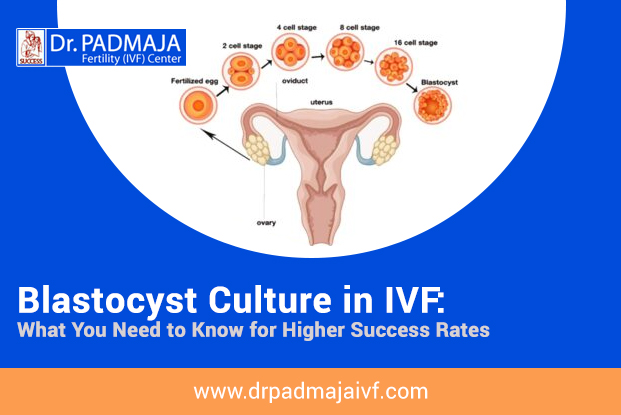In-vitro fertilization (IVF) has brought hope to millions of couples struggling with infertility. Over the years, advancements in technology and techniques have significantly improved success rates. One such breakthrough in modern IVF treatment is blastocyst culture. Many couples today are curious about what this process involves and how it can increase their chances of achieving pregnancy. If you are considering IVF, understanding blastocyst culture can help you make informed decisions. At the best IVF center in Hyderabad, such as Dr Padmaja IVF Center and Dr Padmaja Fertility Center, this advanced technique is offered to maximize success.
What is Blastocyst Culture?
Blastocyst culture is a specialized process in IVF where embryos are cultured in the lab for five to six days after fertilization, instead of the usual two to three days. By extending the culture period, embryologists allow the embryo to reach the blastocyst stage—a stage where it has developed into around 100–120 cells.
At this point, the embryo has a higher potential to implant in the uterus successfully. This is because embryos that make it to the blastocyst stage are considered more robust and viable, increasing the chances of pregnancy.
Why is Blastocyst Culture Important in IVF?
In traditional IVF, embryos are usually transferred to the uterus on day two or three. However, not all early-stage embryos have the potential to grow into healthy pregnancies. By waiting until day five or six, doctors can better identify which embryos are stronger and more likely to implant.
Some of the key benefits include:
Better Selection of Embryos – Only the healthiest embryos survive to the blastocyst stage, allowing doctors to transfer the best ones.
Higher Success Rates – Because of better embryo selection, implantation chances improve, leading to higher pregnancy rates.
Reduced Multiple Pregnancies – With stronger embryos available, doctors can transfer fewer embryos, reducing the risk of twins or triplets.
Closer to Natural Timing – In natural conception, embryos typically reach the uterus around day five. Blastocyst transfer mimics this natural timeline.
Who Can Benefit from Blastocyst Culture?
Blastocyst culture is not necessary for every IVF patient, but it is particularly beneficial for:
Couples who have multiple good-quality embryos on day three.
Patients with previous failed IVF cycles.
Couples looking to avoid multiple pregnancies by transferring fewer but stronger embryos.
Those undergoing preimplantation genetic testing (PGT), as blastocyst culture provides better embryos for analysis.
At Dr Padmaja IVF Center, every case is evaluated individually, and blastocyst culture is recommended only when it can truly add value to the treatment.
The Process of Blastocyst Culture
Here’s how the procedure typically works:
Egg Retrieval and Fertilization – Mature eggs are retrieved and fertilized with sperm in the lab.
Embryo Development – Fertilized embryos are monitored for growth during the first few days.
Extended Culture – Instead of transferring embryos early, they are kept in a special nutrient-rich culture system until day five or six.
Blastocyst Formation – Embryologists assess which embryos have reached the blastocyst stage.
Embryo Transfer – One or two of the healthiest blastocysts are selected and transferred to the uterus.
Freezing Extra Embryos – Any remaining good-quality blastocysts can be frozen for future use.
Success Rates with Blastocyst Culture
One of the main reasons blastocyst culture is popular is because it leads to higher implantation and pregnancy rates. Studies show that transferring blastocysts often doubles the chances of success compared to early-stage embryos.
At reputed clinics such as Dr Padmaja Fertility Center in Hyderabad, blastocyst culture has been instrumental in helping couples achieve positive outcomes even after several failed attempts elsewhere. With advanced lab facilities and experienced embryologists, the process is carried out with precision, giving patients renewed hope.
Why Choose Dr Padmaja IVF Center for Blastocyst Culture?
When you are searching for the best IVF center in Hyderabad, choosing a clinic with expertise in advanced technologies like blastocyst culture is essential. Dr Padmaja IVF Center and Dr Padmaja Fertility Center are widely recognized for their patient-focused care and high success rates. Here’s why couples trust them:
Expertise & Experience – With decades of experience, Dr. Padmaja and her team bring unmatched knowledge in fertility treatments.
Advanced Lab Facilities – Equipped with state-of-the-art embryology labs, ensuring a safe and supportive environment for embryo growth.
Personalized Care – Every couple receives customized treatment plans, including the decision on whether blastocyst culture is right for them.
Ethical Practices – The clinic emphasizes transparency, compassion, and honest communication.
Things to Consider
While blastocyst culture offers many advantages, it is important to note that not all embryos survive the extended culture period. Some patients may have fewer embryos available for transfer. Therefore, the decision should be made carefully after discussing with your fertility specialist.
Couples should also understand that while blastocyst transfer improves chances, it does not guarantee success. IVF outcomes depend on several factors such as age, egg quality, sperm health, and overall medical history.
Conclusion
Blastocyst culture represents a significant advancement in the field of IVF, giving couples higher chances of success by selecting the most viable embryos. For couples in Hyderabad looking for trusted fertility care, Dr Padmaja IVF Center and Dr Padmaja Fertility Center provide world-class expertise in blastocyst culture and other advanced fertility treatments.
If you are on your parenthood journey, choosing the best IVF center in Hyderabad with cutting-edge technology and compassionate care can make all the difference. With the right guidance and treatment, your dream of starting a family could soon become a reality.
About the Author

This blog is penned by a devoted content specialist passionate about raising awareness around fertility treatments and emotional well- being. With in- depth disquisition on motifs like IVF and fertility, the thing is to give precious perceptivity for couples on their trip to parenthood.
Frequently Asked Questions (FAQs)
1.What is blastocyst culture in IVF?
Blastocyst culture is a technique in IVF where embryos are grown in the lab for 5–6 days until they reach the blastocyst stage before being transferred into the uterus.
2.How is blastocyst culture different from day 3 embryo transfer?
In a day 3 transfer, embryos are placed in the uterus earlier, while blastocyst culture allows embryos to grow longer in the lab, increasing the chances of selecting the healthiest ones.
3.Why does blastocyst culture improve IVF success rates?
Blastocysts have a higher chance of implantation because they are more developed and can better synchronize with the uterine lining.
4.Who can benefit most from blastocyst culture?
It is especially beneficial for couples with multiple good-quality embryos, patients with previous IVF failures, and those seeking single embryo transfer to reduce the risk of multiples.
5.Are all embryos suitable for blastocyst culture?
Not always. Some embryos may stop growing before day 5, so blastocyst culture is generally recommended when there are multiple healthy embryos available.
6.Does blastocyst culture increase the chances of twins?
Not necessarily. With blastocyst culture, doctors often transfer fewer embryos, which actually reduces the chances of multiple pregnancies while maintaining high success rates.
7.Is blastocyst culture safe for the embryo?
Yes, it is safe. The embryos are cultured in advanced lab conditions that mimic the natural environment of the fallopian tube and uterus.

